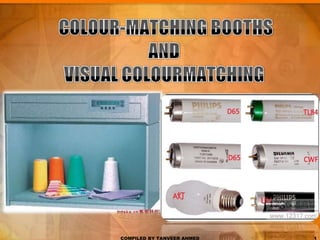
1.7 textile color matching booth
- 1. COMPILED BY TANVEER AHMED 1
- 2. Table of Contents Introduction Light source in Booth Booth Design Booth Viewing Arrangement
- 3. Introduction 1.the nature and intensity of the light source 2. the angle of illumination and viewing of the samples 3. the colour of the surrounds and sample background 4. the size and distance apart of the samples 5. the state of adaptation of the observer 6.the observer’s colour vision characteristics 7. an agreement on the colour-difference terms to be used. COMPILED BY TANVEER AHMED 3
- 4. Introduction The modern colour-matching booth takes into account the first three of these factors, whilst recommendations can be laid down for standardising (as far as is possible) The state of adaptation of the observer and for pre-testing assessors for their colour vision characteristics For the consistent use of colour-difference terms o the observers o must be appropriately trained o and experienced in colour-difference assessments.
- 5. Light sources in colour-matching booths Most colour-matching booths provide a selection of light sources available, with press button accessibility. Typical sources that might be available include: an ‘artificial daylight’ source, often labelled (incorrectly) D65 a tungsten-filament source a three-band fluorescent source (TL84) a UV source (for enhancing fluorescent whites). COMPILED BY TANVEER AHMED 5
- 6. Light sources in colour-matching booths Artificial daylight sources can be filtered tungsten-filament lamps but in the UK are more likely to be ‘artificial daylight’ fluorescent tubes conforming to BS950 : Part 1 : 1967 (artificial daylight for the assessment of colour). Such lamps have a specified UV content that is useful for assessing fluorescent whitening agents on textiles, paper and plastics. No internationally acceptable daylight simulator conforming closely to the D65 specification has yet been developed . Users of matching booths should be aware of the SPD of the lamps provided, as many different combinations of sources are marketed.
- 7. Light sources in colour-matching booths The illumination levels are usually specified and can vary typically from 700 lux to over 3000 lux, the latter value being preferred when matching dark colours. The illumination level should be checked routinely and the lamps replaced when the output drops by a specified value, or after sources have been run for a specified number of hours. With artificial daylight sources it is usually the UV content that declines Most rapidly. It is useful to provide a check of the ‘colour balance’ characteristics, i.e. a test for the maintenance of the SPD within acceptable limits (which test should be in addition to the illumination level test).
- 8. Light sources in colour-matching booths The provision of other sources, such as the tungsten-filament and the TL84 lamps, allows for checks of colour constancy and meta-merism of sample pairs, the latter being assessed by the extent of the change in the quality of colour match when the illuminant is changed (from daylight to tungsten-filament lamp, for example).
- 9. Matching booth design and sample viewing arrangements COMPILED BY TANVEER AHMED 9
- 10. Matching booth design In the typical matching booth the lamps are placed in a recess directly above the matching surface, preferably behind a frosted glass cover and/or filter glass which provides reasonably diffuse illumination (Figure 1.21). The matching surface and the interior of the matching booth should be painted a light to medium grey (about 30% reflectance), and the booth placed at a height such that the viewing angle for the observer of average stature is approximately 45°.
- 11. Matching booth viewing Specimens to be compared should be placed side by side on the same plane. The closer together they are, the more the dividing line between the specimen tends to disappear, so assisting the precision of colour-difference assessment. The position of the sample pairs being compared (sample and standard) should be interchanged to avoid any bias in viewing them in only one order. Samples with surface texture or gloss may need to be viewed at slightly different angles to eliminate surface texture effects or to give some assessment of the gloss, but this should not be a noticeable effect if the viewing illumination is truly diffuse. Some matching booths have a directional light source for assessing gloss, but the assessment of surface gloss requires a matching booth of different and specific design.
- 12. Matching booth viewing When sample and standard are of different sizes it can be helpful to prepare Appropriate aperture masks, by cutting rectangular holes in a sample of a grey card. Such masks should always be used when comparing a large sample with a small chip from a colour atlas (when attempting to obtain a Munsell colour specification, for example).
- 13. Matching booth viewing ( According to Hunter ) According to Hunter, the general rules for visual examination are as follows : (a) Place the specimens in immediate juxtaposition; as the dividing line separating objects becomes thinner, visual differences become easier to see. (b) Keep the intensity of illumination high; only at light levels approaching those of an outdoor overcast sky does the eye make comparisons with its maximum precision. (c) Have the background similar to the specimens (if anything, greyer) so that it offers no distracting contrast with the visual task. (d) Have the illumination spectrally representative of that normally employed in critical commercial studies, usually actual or artificial daylight.
